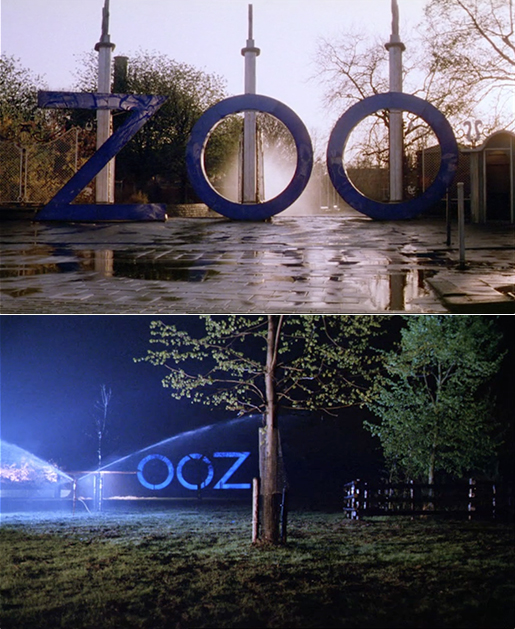A Few Bits on A ZED AND TWO NOUGHTS (1985)

Peter Greenaway’s sumptuously decadent film A Zed and Two Noughts (1985) is one that sates both the visceral and cerebral palettes. One of the main themes that Greenaway presents is his “…fascination of twinship… particularly conjoined Siamese twins.”¹ Not only do the twin brothers progressively shed their individualistic fashion traits to look more alike, but Greenaway also conspires to make the composition of select shots throughout the film look synchronized. In this particular image of a lavish, heaven-like hospital room, the left side of the frame is practically mirrored with the right side. Production designers Ben van Os and Jan Roelfs place the furnishings to reflect one another across each other with a mathematical exactness.

From the long shot, the items on the tables between the bedridden Alba Bewick (Andréa Ferréol) match each other by the shape of their own whole as well as the shared value in colours. A close-up inspection of the items show they are actually varied with a phone within arm’s reach on the left side where Oliver (Eric Deacon) is seated and a plate of green apples close to the right of Oswald (Brian Deacon).
The significance of these items next to these particular characters is revealed in later scenes. Oliver will insist on calling his brother Oswald for help after swallowing some broken windshield glass, which will bring their relationship closer together. In Oswald’s case, he begins his photographic study on decay starting with a green apple. Why a green apple and not a red one? Green is a color often associated with sickness and its sour taste leads smoothly to the subject of disintegration.
Amongst the pictorial harmony, also consider the metallic circles attached Alba’s bed center in the frame. The one behind her makes an absurd halo that frames her redhead. The one in front of her is not only targeting her sex, which the men between her will eventually fall for, but it also encircles the major break in the synchronization of the image — she is missing a leg to balance the other one out.
Considering the high degree of Greenaway’s obsession with pictorial codes and hidden meanings, it is much harder to determine if such a reading is shared by the author or is mine alone. However, it is much easier to be convinced by the cunning of Os and Roelf’s designs.

Greenaway is fascinated by “…the interrelationship of animals, plants and humans (that sets the movie as) …an examination of the world as a zoo. Particularly a human zoo.”1 In Oliver’s dark grey apartment, the zoo prostitute Venus de Milo (Frances Barber) playing wife looks like the warmest addition leaning against the doorframe centered in the shot. Yet her form and colours complement and even threaten to blend with the cold, modernistic furnishings of leather, glass, sleek metals, and slices of lemon.
Making the apartment look much more dangerous is the camera mounted on a sharp-looking tripod to the right of the frame. Creating more tension are two other tripods on top of storage compartment containing a film projector, which also look like thin-wired triangles suspended at Venus’s eye level. The white-bordered black paintings synchronized along with the chairs in the frame are painted with abstract white shapes that inspire even slicker thoughts.

Most important is the use of vertical black lines going down the wall. Venus is ultimately being framed by the set design into being trapped in a metaphorical cage much like the animals at the zoo she frequents. Greenaway expert Douglas Keesey notes, “…(the) choice to focus on striped animals— tigers, angel fish, zebra— is a reminder that we all carry our own prison bars, whether or not we are literally encaged.”²

The one time Venus is ever seen in her home is in this wildly fanciful and cushy set. In the foreground among Venus’ creature comforts are a dozen boxes of Camel – another animal! – cigarettes lying on top of yarn and fabrics. Emphasizing the féminité environment is a large, thick circular cut of glass behind Oswald (or is it Oliver?). The characters are arranged around the set pieces as though they were birds in a warm, cluttered nest. Of immense interest in Greenaway’s visual scheme is the dressmaking model sans head and limbs.

The deliberation and order that Greenaway brings to Os and Roelfs’ set designs he captures is ironic seeing as how the main event that captures the twin husbands’ attention completely is their wives’ death by car crash – a meaningless accident. While the viewers watch these images, they can contemplate how the subtle offsets to otherwise level and harmonious compositions are really broken illusions that reflect their chaotic reality.
ANNOTATIONS
1. ZOO: An Introduction by Peter Greenaway.
Dir. Laurel Warbrick-Keay. The British Film Institute, 2003. Film.
2. Keesey, Douglas. The Films of Peter Greenaway: Sex, Death and Provocation.
Jefferson, North Carolina and London: McFarland & Company, Inc., 2006, p. 27.

A ZED AND TWO NOUGHTS Main Title Sequence
A ZED AND TWO NOUGHTS Trailer
A ZED AND TWO NOUGHTS Introduction


© 2008 – 2024, CINELATION | Movie Reviews by Chris Beaubien. All rights reserved.
















